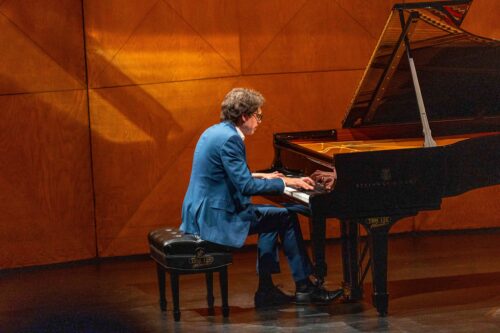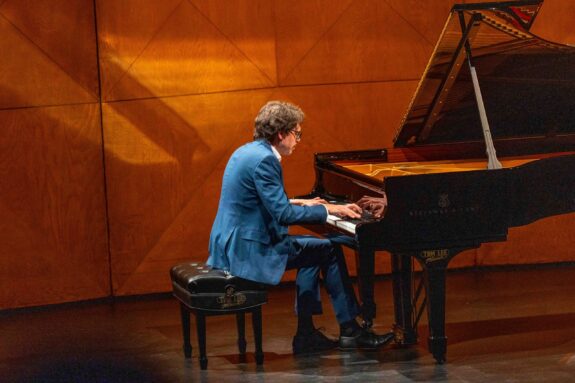 Canada Fauré, Beethoven, Chopin: Lucas Debargue (piano). Vancouver Playhouse, Vancouver, 17.2.2025. (GN)
Canada Fauré, Beethoven, Chopin: Lucas Debargue (piano). Vancouver Playhouse, Vancouver, 17.2.2025. (GN)

Fauré – Préludes, Op.103; Thème and variations in C-sharp minor, Op.73
Beethoven – Piano Sonata No.14 in C-sharp minor, Op.27 No.2, ‘Moonlight’; Piano Sonata No.27 in E minor, Op.90
Chopin – Scherzo No.4 in E major, Op.54; Ballade No.3 in A-flat major, Op.47
Young French pianist Lucas Debargue has had a great run of success since placing fourth in the 2015 International Tchaikovsky Piano Competition, and he has already released widely praised Sony recordings of Scarlatti and, most recently, the complete piano works of Gabriel Fauré. Most of us likely came for his Fauré and it proved rewarding, perhaps bigger structurally than some interpretations but carefully worked out with evident flow and telling contrast. Debargue has already established a reputation as something of an enfant terrible through his intellectual ‘experiments’ in performing well-known pieces, and we had a taste of that too – in his Beethoven and Chopin. While I am sure these latter interpretations prompted strongly differing reactions from attendees, what is not in doubt is the young pianist’s stunning technical assurance and his complete command over the instrument.
Debargue’s love affair with Fauré started from the composer’s nine Préludes, and these received strong characterization here. They are far from the best known of the composer’s piano works, and this performance was an accomplishment of sorts since some other pianists have left me with feeling that these late pieces were only of slight interest. Debargue has an ability to set down a coaxing flow that draws the listener in, and his telling touch allows him to clarify the inner lines of each piece with beauty and significance. He also showed considerable mastery at suspending Faure’s dreamier sequences at very soft volumes.
Many of the same virtues were present in the popular Thème et variations, though I found this a straighter and less intimate performance than I might have expected. The opening theme was given a sort of Brahmsian weight and had very little hint of a resolute trudge under duress that others have found. In bringing out the extremes in the piece, the more active variations were also given a strong, virtuoso projection that I found slightly foreign to the composer. That said, much of Debargue’s playing was genuinely beautiful, and there was always a thoughtfulness at work. There is a rich, inviting quality to the tonal resources he uses, though sometimes I think he overpedals.
Debargue’s searching deliberation opens up some new perspectives on Fauré’s music, but it can also be said that his treatments do not often coax out the sparkle, caprice and innocent joy that others have found in the composer’s spontaneous weavings. I am thinking particularly of the classic 1970s performances of Jean-Phillipe Collard, which still serve as a personal reference for articulating the composer’s uniquely-intimate expressive world and the airy, capricious motion in the music. Since then, there has been a movement to pay more attention to the passionate side of the composer, giving his pieces greater emotional weight, and it is indeed true that Kathryn Stott is more wide-ranging than Collard, and now Debargue and Louis Lortie offer further expansions. But I admit I have never fully understood this inspiration: didn’t the composer himself state that his piano works must never be ‘overstated’?
The ‘experiments’ began with the two Beethoven sonatas. The opening movement of the ‘Moonlight’ was taken at a very slow tempo – perhaps even slower than Solomon’s famous traversal – but Debargue’s superlative control made it work. The secret was to give the anchoring bottom notes a very strong punctuation which summoned the feeling of ‘tolling bells’ that go on inexorably. This gave the whole movement a very dark hue and had a similar effect to Ravel’s ‘Le Gibet’ in Gaspard de la Nuit. This treatment is in some ways not controversial: it squares with Beethoven’s pupil Czerny, who regarded the movement as ‘a ghost scene, where out of the far distance a plaintive ghostly voice sounds’. However, the usual relaxation in the Allegretto was not to be found, since the movement was broken down into structural fragments and presented as a sharply chiseled minuet. I did not really enjoy it. The finale was terrifically quick and passionate and delivered with tempestuous virtuoso energy. There was some fine work on isolating inner voices en route, but it came off a bit calculated and larger than life. It is a valid interpretation all the same, and it certainly showed off just how supreme Debargue’s control of the instrument can be.
The opening movement of Sonata No.27 was also dissected apart in the same way as the Moonlight’s Allegretto but, for all the detail it unearthed, these interventions seemed to impede the dramatic development of the movement. I found it frustrating. The Schubertian closing movement is one of the most beautiful of all Beethoven’s piano compositions, but here the pianist treated its lovely cantabile theme too breezily to unearth its true joy and beauty.
I liked the pianist’s treatment of Chopin’s Scherzo No.4 and Ballade No.3 better, though with qualifications. Again, Debargue worked very hard to clarify points of structure and unearth detail, and he was successful in taking on the virtuoso challenges posed by both works. His bravura attack was sometimes astonishing. However, the pianist’s tendency toward analytical dissection and micro-management did not allow either work to set off with exactly the right pacing or to flower with a natural flow and freedom. For all the beauty and magnetism of the playing, Debargue seemed to move between the two extremes of analytical deliberation and virtuosity without fully isolating the tender emotional core in between. Still, there was plenty enough here to make the performances interesting.
The two encores were slight but satisfying: the pianist’s transcription of Fauré’s Après un rêve, and his own Toccata in B minor, which mimics compositions by Robert Schumann and Prokofiev with the same title. As a composer as well as a pianist, it is probably truistic to note that Debargue seems very relaxed, natural and not remotely self-conscious in music that he has had a hand in constructing.
Overall, this was a fully entertaining musical experience. Some parts of it were very good, other parts more questionable but, all the same, it is impossible to doubt the strength and range of Lucas Debargue’s talents or his potential to go much further.
Geoffrey Newman
